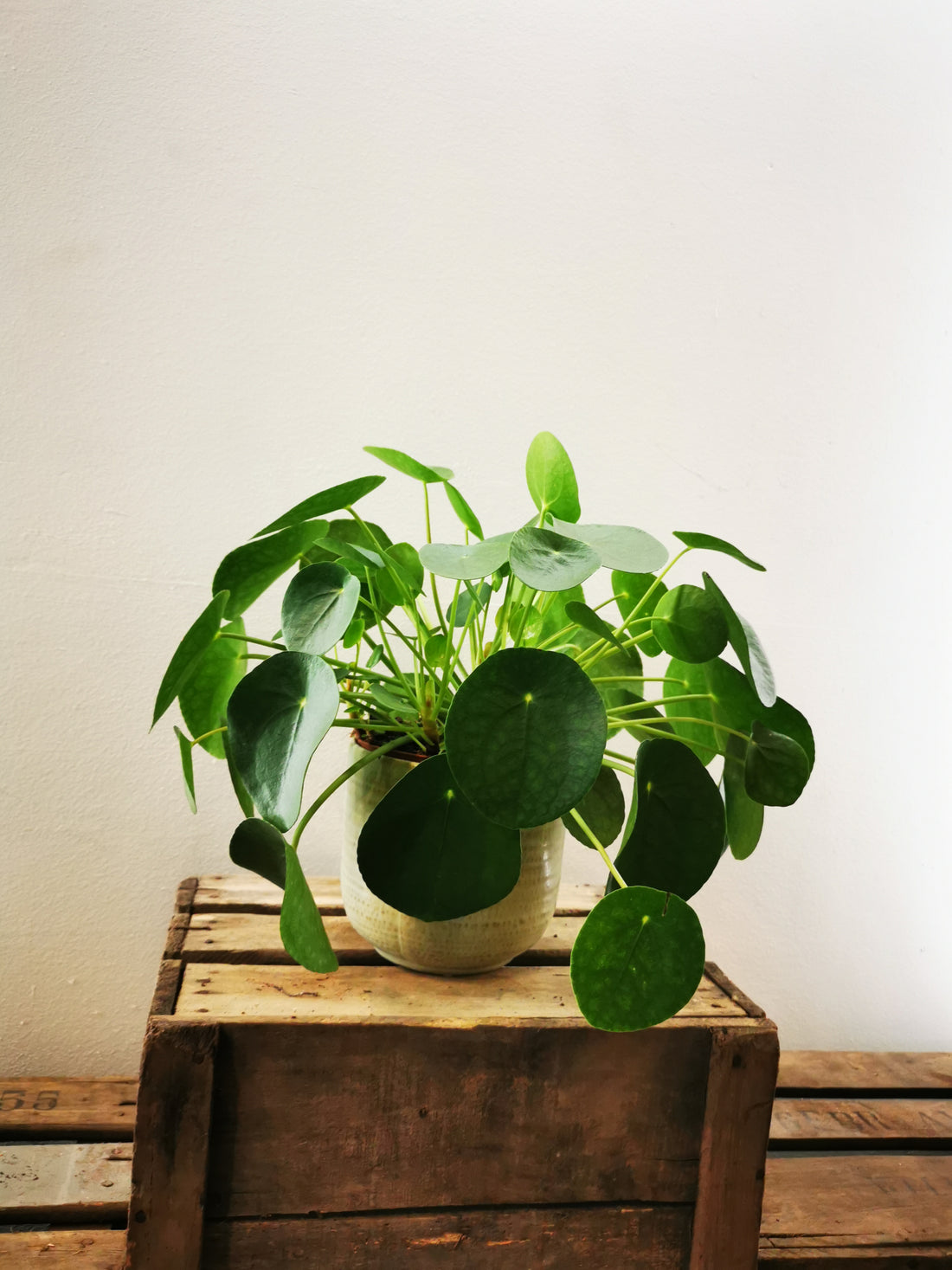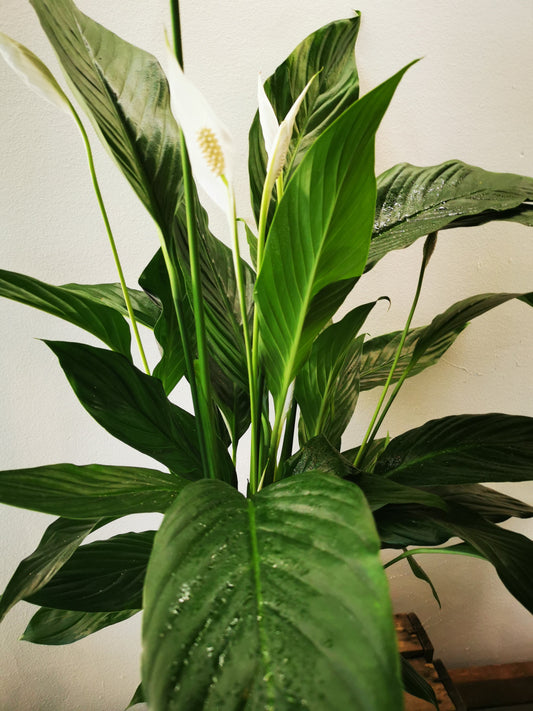
Caring for the Pancake Plant (Pilea Peperomiodes)
Share
If you are looking for a delicious and easy to grow plant, the Pilea is a great choice! This member of the Urticaceae family, originally from Asia, has striking, variegated leaves that resemble pancakes. They grow right up against the Himalayan border, so they can take a beating. They are not only beautiful, but also fast growing and easy to care for. This guide will tell you everything you need to know about the Pilea.
General information about the Pilea Peperomiodes
Where does the pancake plant grow?
The Pilea originates from China and is related to the nettle. This plant has made a comeback in recent years after its popularity in the 70s! It certainly deserves its name 'Pancake plant'. Its round leaves can be 6 to 7 centimetres in diameter and the plant itself can easily grow to 30 cm high. The leaf 'lies' on its thin stem. It is a ground cover, which means that there are always plants sprouting next to the mother plant. In this way, they cover the entire ground.
Different types of Pileas:
- The Pilea Spruceana.
- The Pilea Glauca.
- The Pilea Involucrata.
- Pilea Depressa.
- Pilea Cadierei.
- Pilea Nummulariifolia.
- Pilea peperomiodes ( pancake plant )

Are you looking for a specific type of Pilea ? Please feel free to contact us, we can basically order any plant for you. Order your pancake plant here!
In general, the care of the Pilea is quite simple. Small amounts of water, sufficient light and nutrition in the summer.
Caring for the Pancake Plant
Watering
The Pilea is not a thirsty plant. A little water every week is sufficient. Keep the soil slightly moist. The plant certainly does not like to dry out, but it also does not like to be drowned in water. Make sure that no water remains at the bottom of the pot, otherwise the roots will rot. Read more about root rot here .
Light & location of the pancake plant
He likes light but does not prefer a spot in full sun. This way you avoid burning the leaves. Choose a spot at a northern window. Do not put him in a dark spot but also not in a spot that is too light. If he is in the wrong place you will quickly notice this by the leaves that change.
Extra food and fertilizer for the Pilea
Once a month, in the summer, your pancake will happily eat some liquid plant food. Although this is not necessary. In the fall and winter, the plant rests, then you do not have to do this.
Common Pancake Plant Problems
Are you experiencing problems with your Pancake Plant? Then read on and let's solve this!
Yellow leaves of the pancake plant
Are the leaves turning yellow? Then you are probably giving too much water or too little/too much light. Watering once a week is sufficient and do not place your plant in full sun. You can remove the yellow leaves from the stem. This way the plant can put all its energy into the healthy leaves. Even though the Pilea does not necessarily need to be pruned.
Pancake plant losing leaves
It is not uncommon to notice that your pancake plant (Pilea peperomioides) will occasionally lose some of its leaves. This behavior can occur for a number of reasons and is usually not a cause for major concern. The pancake plant may lose leaves in response to changes in its environment, such as changes in light levels, temperature, or humidity. It can also occur as the plant ages and naturally sheds its lower leaves to conserve energy for new growth.
Proper care, including adequate light, moderate watering, and occasional fertilization, can help keep this leaf loss to a minimum. However, if you notice your pancake plant losing an excessive amount of leaves, accompanied by other signs of problems such as wilting, discoloration, or pests, it is important to investigate the cause thoroughly. This can range from improper watering to pot-bound roots or pests. By paying close attention to your plant’s signals and taking the appropriate measures, you can keep your pancake plant healthy and lush.
Pancake plant has brown spots
Brown spots on the leaves of your pancake plant (Pilea peperomioides) can be a sign that something is wrong with the health of the plant. Here are some possible causes and solutions for brown spots on leaves:
-
Too much direct sunlight: Pancake plants like bright, indirect sunlight. Too much direct sunlight can burn the leaves, resulting in brown spots. Move the plant to a location with softer light.
-
Irregular Watering: Uneven watering can lead to dry spots on the leaves, resulting in brown spots. Provide regular, even watering without allowing the soil to dry out or become soggy.
-
Too low humidity: Pancake plants thrive in a humid environment. If the humidity is too low, the leaves may dry out and develop brown spots. Increase the humidity around the plant by using a humidifier or placing a saucer of water nearby.
-
Fungus or Disease: Brown spots can also be caused by fungal growth or disease. Carefully remove affected leaves and treat the plant with a fungicide if necessary.
-
Over-fertilization: Too much fertilizer can damage the roots and lead to brown spots on the leaves. Make sure you use the right amount of fertilizer and follow the recommended fertilization guidelines.
It is important to determine the cause of the brown spots and take the appropriate measures to prevent further damage. With the right care and attention, you can restore the health of your pancake plant and ensure that it thrives.
Can my Pilea peperomiodes get diseases?
Fortunately, he is not so sensitive to bugs and diseases. But there is always a chance that he has Mildew. What is Mildew? This is a fluffy white mold that gets on the leaves. This can occur in warm and humid weather. This mold then takes the moisture from the plant. As a result, the plant turns brown and dries out. How do you tackle this? Remove the Mildew and place the plant in a place with ventilation. You can also make a pesticide yourself with 40% milk and 60% water. Spray the plant with this until the mold disappears.
Is the pancake plant poisonous?
The Pilea peperomioides is known to be a non-toxic plant. This means that the plant is generally safe for both humans and pets. However, it is always wise to take precautions and prevent small children or pets from ingesting the leaves or other parts of the plant.
Although Pilea peperomioides is generally considered non-toxic, it is important to keep in mind that individual sensitivities and allergic reactions can vary.
When in doubt, it is advisable to contact a healthcare professional or veterinarian for more specific information about the safety of Pilea peperomioides in your particular situation.
Propagating the Pancake Plant
Do you want small cute Pancake plants? You can easily grow them yourself! This is called 'cuttings' or 'propagation'. Small plants grow along the side of the mother plant. When these are a bit bigger, you can carefully cut them off and put them in a separate glass with water. After a while, roots will grow from this. Don't forget to refresh the water regularly. After they have grown roots, you can place the cuttings in new potting soil and care for the plant as we discussed above.
Click here for a more detailed explanation of how to propagate the pancake plant .
The Plantrekkers are happy to help you find a suitable plant. Or do you have any questions ? Feel free to send us an email to hello.plantrekkers@gmail.com or DM on Instagram @deplantrekkers .
See you then!



